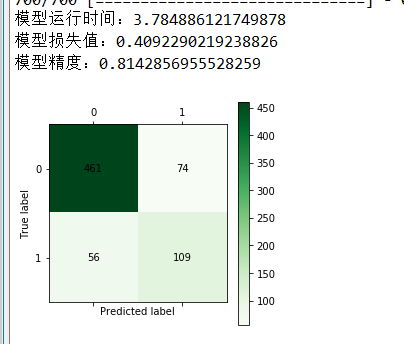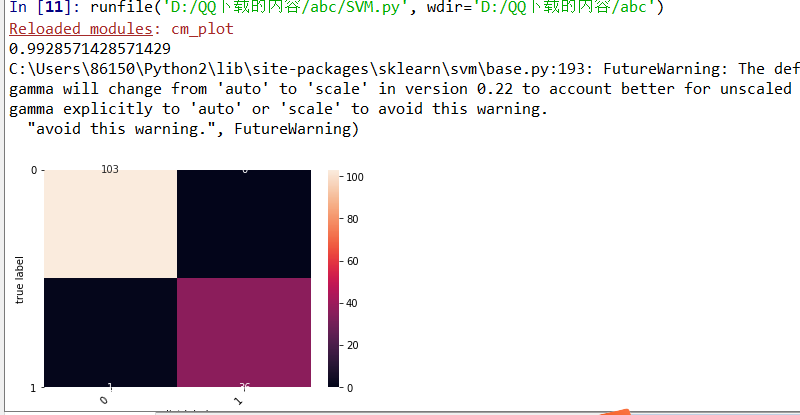行分控模型的建立
数据预处理:
# -*- coding: utf-8 -*- """ Created on Tue Mar 29 18:52:22 2022 @author: 86150 """ #-*- coding: utf-8 -*- def cm_plot(y, yp): from sklearn.metrics import confusion_matrix #导入混淆矩阵函数 cm = confusion_matrix(y, yp) #混淆矩阵 import matplotlib.pyplot as plt #导入作图库 plt.matshow(cm, cmap=plt.cm.Greens) #画混淆矩阵图,配色风格使用cm.Greens,更多风格请参考官网。 plt.colorbar() #颜色标签 for x in range(len(cm)): #数据标签 for y in range(len(cm)): plt.annotate(cm[x,y], xy=(x, y), horizontalalignment='center', verticalalignment='center') plt.ylabel('True label') #坐标轴标签 plt.xlabel('Predicted label') #坐标轴标签 return plt
# -*- coding: utf-8 -*- """ Created on Tue Mar 29 18:52:22 2022 @author: 86150 """ #-*- coding: utf-8 -*- def cm_plot(y, yp): from sklearn.metrics import confusion_matrix #导入混淆矩阵函数 cm = confusion_matrix(y, yp) #混淆矩阵 import matplotlib.pyplot as plt #导入作图库 plt.matshow(cm, cmap=plt.cm.Greens) #画混淆矩阵图,配色风格使用cm.Greens,更多风格请参考官网。 plt.colorbar() #颜色标签 for x in range(len(cm)): #数据标签 for y in range(len(cm)): plt.annotate(cm[x,y], xy=(x, y), horizontalalignment='center', verticalalignment='center') plt.ylabel('True label') #坐标轴标签 plt.xlabel('Predicted label') #坐标轴标签 return plt
w Code
二、神经网络算法建立模型
1 # -*- coding: utf-8 -*- 2 """ 3 Created on Tue Mar 29 18:55:21 2022 4 5 @author: 86150 6 """ 7 8 import pandas as pd 9 import numpy as np 10 #导入划分数据集函数 11 from sklearn.linear_model import LogisticRegression as LR 12 from sklearn.model_selection import train_test_split 13 #读取数据 14 datafile = 'data5/bankloan.xls'#文件路径 15 data = pd.read_excel(datafile) 16 x = data.iloc[:,:8] 17 y = data.iloc[:,8] 18 #划分数据集 19 x_train, x_test, y_train, y_test = train_test_split(x, y, test_size=0.2, random_state=100) 20 #导入模型和函数 21 from tensorflow.keras.models import Sequential 22 from tensorflow.keras.layers import Dense,Dropout 23 #导入指标 24 from tensorflow.keras.metrics import BinaryAccuracy 25 #导入时间库计时 26 import time 27 start_time = time.time() 28 #-------------------------------------------------------# 29 model = Sequential() 30 model.add(Dense(input_dim=8,units=800,activation='relu'))#激活函数relu 31 model.add(Dropout(0.5))#防止过拟合的掉落函数 32 model.add(Dense(input_dim=800,units=400,activation='relu')) 33 model.add(Dropout(0.5)) 34 model.add(Dense(input_dim=400,units=1,activation='sigmoid')) 35 36 model.compile(loss='binary_crossentropy', optimizer='adam',metrics=[BinaryAccuracy()]) 37 model.fit(x_train,y_train,epochs=100,batch_size=128) #调参 epochs:训练次数,此处为100次 38 loss,binary_accuracy = model.evaluate(x,y,batch_size=128) 39 #--------------------------------------------------------# 40 end_time = time.time() 41 run_time = end_time-start_time#运行时间 42 43 print('模型运行时间:{}'.format(run_time)) 44 print('模型损失值:{}'.format(loss)) 45 print('模型精度:{}'.format(binary_accuracy)) 46 47 yp = model.predict(x).reshape(len(y)) 48 yp = np.around(yp,0).astype(int) #转换为整型 49 from cm_plot import * # 导入自行编写的混淆矩阵可视化函数 50 51 cm_plot(y,yp).show() # 显示混淆矩阵可视化结果

三、SVM支持向量机算法模型
1 # -*- coding: utf-8 -*- 2 """ 3 Created on Tue Mar 29 19:08:49 2022 4 5 @author: 86150 6 """ 7 8 from sklearn import svm 9 from sklearn.metrics import accuracy_score 10 from sklearn.metrics import confusion_matrix 11 from matplotlib import pyplot as plt 12 import seaborn as sns 13 import pandas as pd 14 import numpy as np 15 from sklearn.model_selection import train_test_split 16 data_load = "data5/bankloan.xls" 17 data = pd.read_excel(data_load) 18 data.describe() 19 data.columns 20 data.index 21 ## 转为np 数据切割 22 X = np.array(data.iloc[:,0:-1]) 23 y = np.array(data.iloc[:,-1]) 24 X_train, X_test, y_train, y_test = train_test_split(X, y, random_state=1, train_size=0.8, test_size=0.2, shuffle=True) 25 svm = svm.SVC() 26 svm.fit(X_test,y_test) 27 y_pred = svm.predict(X_test) 28 accuracy_score(y_test, y_pred) 29 print(accuracy_score(y_test, y_pred)) 30 cm = confusion_matrix(y_test, y_pred) 31 heatmap = sns.heatmap(cm, annot=True, fmt='d') 32 heatmap.yaxis.set_ticklabels(heatmap.yaxis.get_ticklabels(), rotation=0, ha='right') 33 heatmap.xaxis.set_ticklabels(heatmap.xaxis.get_ticklabels(), rotation=45, ha='right') 34 plt.ylabel("true label") 35 plt.xlabel("predict label") 36 plt.show()








 浙公网安备 33010602011771号
浙公网安备 33010602011771号